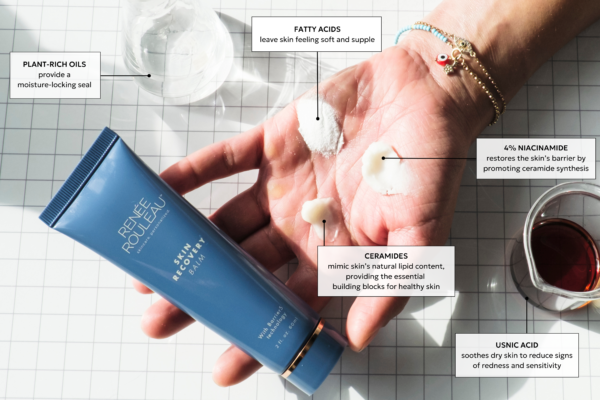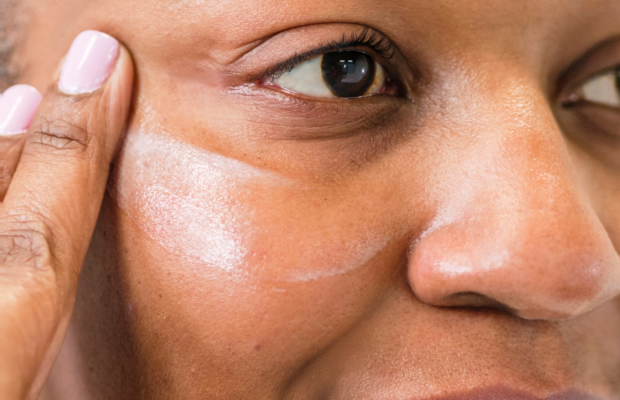Let’s talk about dry skin. Chances are, if you’re over the age of 40, your skin’s natural oil production has slowed down and now you are wondering what type of moisturizer is best for dry skin. Sound about, right? Most dry skin moisturizers are loaded with what are called “occlusives” which are oils that give a thick, greasy feel but is this type of moisturizer truly correcting your skin dryness?
Well, let me just start by saying this. Moisturizers have come a long way and your mother’s moisturizer of yesteryears didn’t work as well as the ones formulated today. Yet, many product formulators haven’t innovated and you may not be giving your dry skin what it truly requires.
In this post, I’ll educate you on how moisturizers actually work, why formulas aren’t truly getting to the root of the issue and what you should be looking for when deciding how to choose a moisturizer for dry skin. Let’s dive in!
The History of Moisturizers
The use of moisturizers for treating dry skin dates back thousands of years with civilizations using natural remedies like animal fats, lanolin (derived from sheep wool), oils found in almonds and olives and beeswax. These all have an oily feel on the skin but worked to alleviate skin tightness and give a soft, supple feel to the skin.
In the 19th century, cold cream was invented and in later years, petroleum jelly. These also have an oily feel which would make dry skin feel better and less tight.
With the rise of cosmetic science and dermatology, moisturizers became highly specialized and commercial moisturizers were developed using not only oils (occlusives), the addition of water and emulsifiers.
Fast forward to today, moisturizers are continually being modernized to meet the needs of what we now need in a dry skin moisturizer, but it is not enough.
What made us believe that a heavy, oil-based moisturizer is the most effective for dry skin?
- Oils give the illusion of a glow. Oils give an immediate shine once applied and it reflects light so the skin does in fact look better. But that doesn’t mean it truly corrected the dryness from within.
- A false sense of relief. Oils create suppleness and when a greasy moisturizer is applied and you talk or move your face around, you don’t feel that “pull” or “tightness” on the skin. People associate this feeling with not being dry. This is simply a feeling. Again, it doesn’t mean that it improves skin dryness.
- We’ve come to expect a certain type of moisturizer for dry skin – something with occlusives that are heavy and topical. This has been passed down from our mother’s and grandmother’s moisturizers who–for most of us–were our original skincare influencers.
What does my dry skin really need?
- Water/hydration. Both dry skin and oily skin require water. Skin cells are like fish and need water to live! This means, using a toner within 60 seconds after cleansing and leaving it on damp. Use a hyaluronic acid or humectant-rich serum under moisturizer to deliver skin-plumping hydration. Learn the difference between dryness and dehydration and watch this video. Also, drinking water won’t hydrate your skin, but these three things will.
- Oil. Only dry skin types require oil since oily skin has it already built in.
- A well-formulated moisturizer for dry skin, regardless of how thick or heavy it is. Don’t fall into thinking that just because something is rich and greasy, that it’s the cure-all. Sometimes a moisturizer can add the required hydration and oil to the skin without just sitting on the top of the skin.
- Repair of your skin’s barrier. To truly correct dryness you need to repair from inside the skin, not just on the skin’s surface. Learn about fixing a damaged skin barrier.
- Avoiding the use of harsh products and ingredients. Did you know that your vitamin C serum could be creating a “vitamin C acid burn?” Ouch. Not good.
How do I choose a moisturizer for dry skin?
- Don’t judge a product by its weight. You need to look beyond the texture since even lighter textures can provide exceptional hydration and repair. Avoid making assumptions when you encounter a rich, greasy moisturizer.
- Choose dry skin moisturizers that restore the skin barrier. Ingredients listed on a bottle are often hard to sort through but at the very least, if a product is being marketed for “barrier-repair”, that’s a great sign.
- Choose a dry skin moisturizer with these key ingredients. If you really want to get serious about correcting dry skin, look for ingredients like niacinamide, linoleic acid, usnic acid, phytosterols, ceramides, shea butter, squalane, vitamin E, dimethicone and soybean oil, to start. (There are too many to list!) Here are five methods for repairing dry skin.
- Consult with an esthetician or a dermatologist for a dry skin moisturizer recommendation. Trust those who truly know and understand how the skin functions, and what your dry skin needs to be restored.
Did you know that you can get barrier correction without the use of oily occlusives? Oily and acne prone skin doesn’t need the oil dry skin does, but that doesn’t mean their barrier doesn’t need help – especially with the use of acne treatments that can really damage the skin barrier. Look at this before and after!
How long does it take to see an improvement in dryness when using the right moisturizer for dry skin?
A skin’s life cycle is 28 days, so it’s important to give any product time to see results. Dry, flaky skin needs time to cycle out and fall off, giving way to new, soft and supple skin.
If you’re looking for a moisturizer for dry skin (that is surprisingly lightweight, because it doesn’t need to be heavy!) try Skin Recovery Balm. With Barrier5 technology, it repairs the skin barrier by mimicking your skin’s natural lipids, so it hydrates without feeling greasy. It melts in rather than sitting on top, offering a smarter way to correct dryness. After it’s applied, it will initially feel tacky, which comes from hydrating humectants like glycerin and propanediol that lock in moisture. Once it dries, it starts restoring your skin’s barrier, creating a “second-skin” effect that lasts all night long. By morning, your skin will feel buttery soft and replenished.

If you prefer a more traditional, richer feel, layer with Rest Day Masque on top or use a skin oil, but on its own, it provides all the moisture your skin needs for long-term barrier health.
In summary…
As an expert esthetician who has touched thousands of faces, I’m here to tell you need to re-think how you moisturize. After all, it’s a product that you use every single day and you want to get the most benefit. You can’t just rely on a basic heavy, thick, greasy moisturizer to correct dryness. It’s just not enough. You need a dry skin moisturizer that can truly repair the skin so you can be on your way to soft, healthy and dewy skin that glows!
Celebrity Esthetician & Skincare Expert
As an esthetician trained in cosmetic chemistry, Renée Rouleau has spent 30 years researching skin, educating her audience, and building an award-winning line of products. Her hands-on experience as an esthetician and trusted skin care expert has created a real-world solution — products that are formulated for nine different types of skin so your face will get exactly what it needs to look and feel its best. Trusted by celebrities, editors, bloggers, and skincare obsessives around the globe, her vast real-world knowledge and constant research are why Marie Claire calls her “the most passionate skin practitioner we know.”
Source link

